
MANUFACTURER'S SPECIFICATIONS
Frequency Response: 40 Hz to 16 kHz ±5 dB, on axis; 40 Hz to 10 kHz ±10 dB, 60° off axis.
Power Rating: 60 watts peak, 20 watts intermittent, 3 watts continuous. Nominal Impedance: 8 ohms. Sensitivity: 96 dB SPL for 1-watt input at one meter on axis. Harmonic Distortion: Less than 7 per cent at 10-watts input (106 dB SPL at one meter on axis) above 50 Hz.
Dimensions: 25 1 W x 34 5/8 H x 17 1/4 D.
Weight: 110 lbs. (50 kg).
Price: $2,400.00 per pair.
Nakamichi has expanded their product line to include loudspeakers. The loudspeaker introduced under the label Nakamichi Reference Monitor is new in this country, but is a system developed and manufactured by Mitsubishi Electric Corp. and reportedly is used as a studio monitor by the Japan Broadcasting Corporation (NHK) as well as broadcasting stations and recording studios throughout Japan. (Editor's Note: Smaller version of this Nakamichi Reference Monitor Speaker with 8-in. woofer and 1 1-in. tweeter is also available at $1,600.00 per pair.
A 12-in. woofer is used with a bass reflex enclosure of the phase inverter type and is intended to carry the spectrum up to 1500 Hz. Frequencies above that are carried by a 2-in. cone tweeter.
Except for an optically opaque grille cloth which covers most of the front surface, the front, top, and sides are finished with dark lacquer so smooth you can see your reflection in it.
Speaker connection is made through either of the two XLR type receptacles provided, one on either side of the enclosure. While this is fine for a studio monitor, it is not the thing for a normal user to wire up and connect to his home system, even though XLR plugs and complete wiring instructions are included. We would like to see this changed to a more conventional connector for domestic use.
There is no equalization control provided, and the system comes equalized for flat response. To prove that fact, Nakamichi provides an anechoic frequency response measurement and impedance measurement for each system.
When you take delivery of this loudspeaker system, invite a husky neighbor over to help you set it up. At 110 lbs. per speaker and with smooth lacquer sides, this system is quite a handful. Part of the reason for this is that Nakamichi recommends the Reference Monitor be mounted 12 to 15 in. away from a wall and 15 to20 in. off the floor. Four standard cinder blocks are suggested for this purpose under each speaker. The cinder blocks do not come with the unit, so be prepared in the finest spirit of noblesse oblige.
This system is very efficient and can provide brisk sound levels with low and medium power amplifiers. No unusual requirements are imposed on the remainder of the audio system with the obvious exception that only the highest quality components should be contemplated with a loudspeaker system of this quality. Nakamichi supplies a short, but very thorough instruction brochure with the Reference Monitor.
Technical Measurements
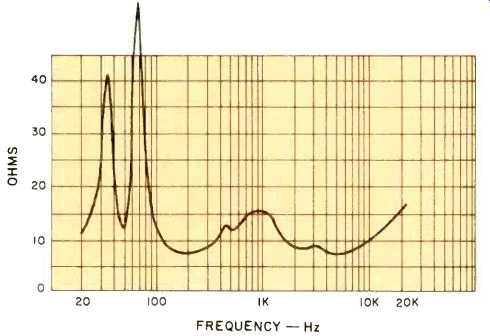
Fig. 1-Impedance.

Fig. 2-Polar impedance plot.
The magnitude of the measured impedance is shown in Fig. 1. The two resonance peaks in the bass frequency region are due to the fact that this system is a vented design. There are some interesting details in the 400 Hz to 4000 Hz region that indicate some interaction of the loudspeaker drivers with their local acoustic environment. The more complete polar impedance plot of Fig. 2 and the expanded scale plot of Fig. 3 show the details of this situation. The two bass resonances occur at 36 Hz and 65 Hz, with values of 42 and 58 ohms respectively. The size of these peaks is not significant to the acoustic response.
The expanded plot in Fig. 3 shows the type of load which this speaker imposes on a power amplifier for the frequency range of 100 Hz to 20 kHz. The nature of this plot indicates that a small amount of acoustic interaction is occurring, probably standing wave patterns within the enclosure.
The lowest high-frequency capacitive load exists at 1.3 kHz and is 12 ohms at an angle of about 30 degrees lagging, which should offer no problems for any good power amplifier. The lowest impedance measures slightly less than 8 ohms.
The one-meter anechoic frequency response is shown in Fig. 4 for its magnitude and Fig. 5 for phase. The sound pressure level in Fig. 4 for a one-watt drive level averages better than 94 dB, which indicates a moderately high efficiency for this system. The low-frequency response falls off rapidly below 50 Hz, a surprisingly high frequency for a professional monitor of this physical size. Since this is a vented system and acoustically unloads so rapidly, it's probably a good idea to use a subsonic cutoff or rumble filter in the preamplifier to prevent subsonic signals from driving the woofer outside its linear range and muddying the response by cross modulation. Such signals could arise from warped records, for example. In a professional recording studio, such program defects do not exist, so a designer need not worry about them.
But the signal environment outside the professional studio is quite another story.
Interestingly enough, an anechoic response plot on this particular speaker, as it was tested in Japan, was supplied with the unit. Our measurements duplicated those of Mitsubishi perfectly with the exception of a slight difference above 10 kHz which was due to the fact that we test on the geometric center line of the speaker, rather than in front of the tweeter where Mitsubishi's measurements were taken.
Moving our microphone to tweeter level verified this, but for standardization we will continue supplying the response taken on the geometric axis. What makes this result significant is not simply the honesty of Mitsubishi, but that their measurement is done in the classic anechoic chamber, while ours is by coherent signal processing, time delay spectrometry, in a quite substantially reverberant room.
The overall response is quite uniform on the average, but has localized variations. These are shown by the subsequent energy-time plot to be due to enclosure and grille diffraction. The effect should be an overall balanced sound with some coloration in timbre as one moves his listening position relative to the enclosure.

Fig. 3-Expanded-scale polar impedance plot.
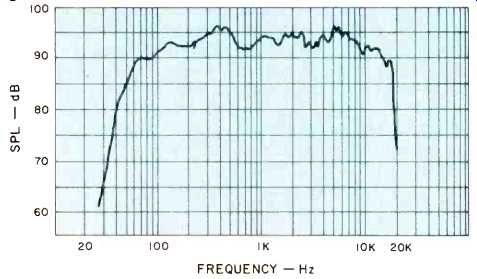
Fig. 4-One-meter anechoic amplitude response at one watt drive.
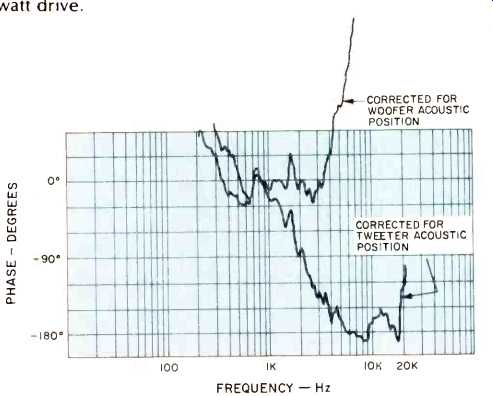
Fig. 5-One-meter phase response.
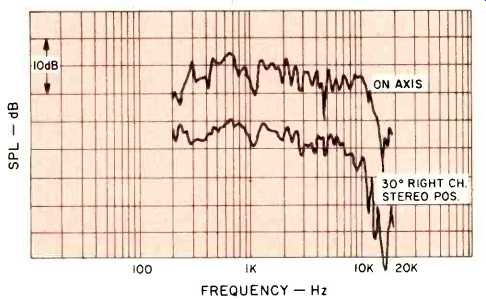
Fig. 6-Three-meter or room response.
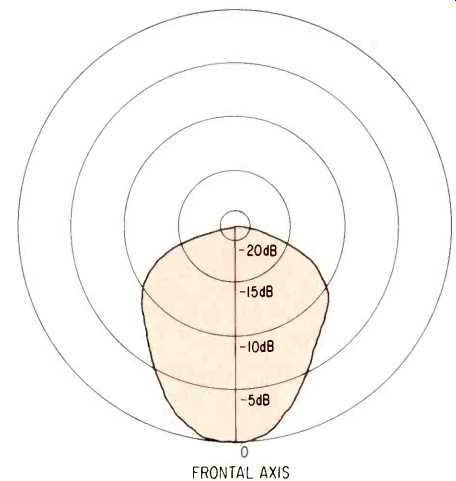
Fig. 7-Horizontal polar energy response.

Fig. 8-Vertical polar energy response.
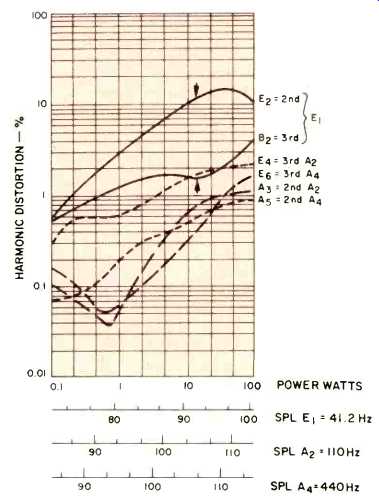
Fig. 9-Harmonic distortion for the tones E1 or 41 Hz, A2 or 110 Hz, and
A4 or 440 Hz.
For those technically minded readers, the sound pressure, measured directly in the vent, peaks at 50 Hz, while the near-field woofer cone pressure dips at 43 Hz and has a lower peak at 39 Hz.
The phase response Fig. 5 was duplicated for the two acoustic positions of the woofer and the tweeter. The response is in-phase for the woofer and, as is common for passive crossover two-way systems, 180 degrees out of phase for the tweeter. The impulse response will be a preliminary under pressure, followed in a few tenths of a millisecond by a swing to overpressure as the listener's location, as the woofer response arrives slightly after the tweeter response.
With the exception of the crossover between drivers, the overall response is principally minimum phase.
Of course, the average listener does not live in an anechoic chamber, but uses a room. The three-meter room test of the Nakamichi Reference Monitor is shown in Fig. 6.
This test was made, in fact, in the exact position used by this reviewer for the listening test. The speakers were placed on a pedestal formed from four cinder blocks, exactly as recommended by Nakamichi. The speaker was away from the wall and angled toward the listening area. The microphone was placed three meters away from the front of the enclosure and at an ear height of one meter above the floor.
The frequency response that is shown is the Fourier transform of the first 13 milliseconds of sound due to a perfect impulse. Two measurements are shown, one with the speaker oriented toward the microphone and the other with the speaker angled 30 degrees away in a manner corresponding to a right-channel stereo unit that is pointing to the right of the listener. The plots are displaced 10 dB for clarity.
The room response is very good for both positions. The extreme top end dropped inexplicably compared to the anechoic response, though a number of early scatter signals were picked up, and the response is good overall. The fact that the average response is so similar for both angle positions indicates high probability of good stereo imagery.
While the off-axis response is some 2 or 3 dB lower than the on-axis, the important thing here is their similarity.
The amount of fall off with horizontal off-axis is shown in the polar energy plot of Fig. 7. This is a computation of the total energy in all components from 20 Hz to 20 kHz and is plotted as a function of angle. This plot shows that the Nakamichi Monitor System should be angled toward the listening position for the most uniform energy balance. There is no apparent left-versus-right bias of energy.
The vertical energy response is shown in Fig. 8. This loudspeaker launches most of its energy upward. The plot shows that, given a choice, this speaker should be mounted closer to the floor than the ceiling. If the speaker is too close to an acoustically hard ceiling, a distinct coloration will result due to ceiling-scattered sound.
Harmonic distortion for the musical tones E1 or 41 Hz, A2 or 110 Hz, and A4 or 440 Hz is shown in Fig. 9. The woofer showed substantial waveform change in the reproduction of E1 (41 Hz) above the 12-watt average level and this is signified by the identifying marks on this plot. All other frequencies were easily handled to 100 watts average power.
However, with the efficiency of this system, I could only recommend such power levels as a means of breaking leases.
With the exception of E1 (41 Hz), which is really below the acoustic cutoff of this speaker, harmonic distortion is reasonably low. The break in characteristic in the 0.1to 1-watt range will be explained later.
Fig. 10 shows the intermodulation of A4 by E1 (or 44-Hz by 41 Hz) when they are mixed in equal portion. The IM at high power levels is astonishingly low. The type of distortion on A4 at an average power of 60 watts is composed of both amplitude and phase modulation, with 3 per cent peak-to-peak amplitude modulation and 5 degrees peak-to-peak phase modulation at 41 Hz. At this drive level, the woofer shifts position toward the listening area by an amount corresponding to 0.02 milliseconds of air path delay, which is totally inconsequential as far as the sonic effect on the frequencies which the woofer is called upon to handle. The IM falls rapidly with decrease in power to a plateau of about 1.3 percent.
The Nakamichi Monitor has an acoustic transfer function that, at frequencies below 350 Hz, has a shelving type increase above 0.1 watt. This is approximately a 0.6 dB increase in gain, somewhat like a program expander. This should give a mild emphasis to sound peaks above this power level, but will also cause a small lateral spread of musical partials in the stereo stage when instrumental voices are in the one watt and above power range. This characteristic is the reason for the unusual low power harmonic distortion property.
The crescendo handling test was passed easily for three sigma noise peaks up to 350 watts. This means that inner musical voices will not become smeared for sudden momentary random signals, such as applause, that have average power in a 20 kHz band that is 20 dB higher than the average power of the musical tone it is riding over.
The energy-time response, which is the square of the true amplitude of the impulse response, is shown in Fig. 11. The main peak at 3.15 milliseconds. The subsidiary peaks are due to diffraction and scatter within the enclosure. The peak at 3.6 milliseconds, which is the largest contributor, is due to sound from the tweeter that travels along the front grille and reradiates from the top of the enclosure. Other subsidiary peaks are due to reflections from grille and associated housing. This is not as good an impulse response as one might expect from a professional monitor speaker. The problems are associated with the physical housing and manifest themselves in two ways. First, the basic frequency response is made somewhat nonuniform for these peaks, and, second, there is a distinct change of timbre with listening position for the very highest range of frequencies that gives an effect equivalent to polar response irregularities. The average energy is uniform, as has been shown, but the details of the response will be very slightly modified.
The sides of the Nakamichi Monitor System are rounded, which is a correct way to minimize, diffraction from the vertical edge discontinuities. This is why there are no broad "clumps" of energy more than a half millisecond following initial sound.
The first dominant arrival at 3.15 milliseconds has the peak of its response at 8.3 kHz, which means a relatively bright sound. Ninety-five percent of the sound energy arrives within 3.3 milliseconds, and ninety-nine percent arrives within 3.7 milliseconds.

Fig. 10-IM distortion of A4 or 440 Hz by E1 or 41 Hz mixed one to one.
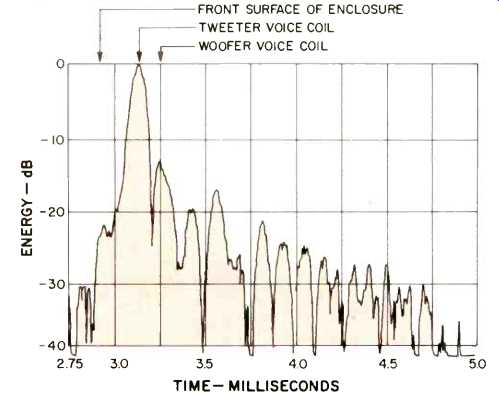
Fig. 11-Energy-time response.
Listening Test
Nakamichi Research provides very explicit recommendations concerning the physical placement of their Reference Monitor System, which were followed to the letter. Four "standard" cinder blocks, measuring 7.5 X 7.5 X 15.5 in. were placed under each speaker to bring them 15 inches off the floor. At 110 lbs. (50 kg) per speaker, the use of cinder blocks is quite logical, if incongruously undecorous. A cloth covering was placed over the cinder blocks prior to hefting the speakers into place.
Standing more than 15 in. away from the back wall, these monoliths make a formidable obstacle that should not be placed where the unwary guest might collide with them. Believe me, the speakers won't budge.
The speakers were tried in both a forward-facing configuration and rotated toward the listening area. Because of discernible polar characteristics, the angled position was chosen for the listening test.
A word of comment on speaker hookup is in order. The Nakamichi Reference Monitor clearly shows its professional heritage by the fact that connection is made to a four-pin XLR type connector. There is an XLR receptacle on each side and they are provided with a locking cap to cover the receptacle not in use. Though it appears this system was originally designed for flush wall mounting, Nakamichi wisely recommends pulling it away from the wall. One problem might arise with the Cannon XLR-4-11C plugs which Nakamichi supplies for hook up. Despite the good instructions supplied, this is not a task many non-professional users will enjoy, even if they have a soldering iron.
Nakamichi also recommends that the user employ a fast acting 2.5-ampere fuse to protect the loudspeaker from damage. In view of the substantial investment which this system represents, this is a wise precaution.
Overall listening impression is that this system is very analytical in that there is very little coloration of timbre over most of the frequency range. It is a sound, or lack of it, that is needed in certain studio applications. But it will not blow your ears off with robust midrange peakiness, if that is the kind of "monitor" you are expecting. While there are definite polar response "fingers," these can be eliminated by rotating the speakers toward the listening area.
The low bass response was found to be somewhat thin, and in fact, a check was made to be certain that the polarity of one channel had not accidently been reversed with respect to the other. Though this thinness was most noticeable with super low frequency organ music, percussive bass sounded clean to my ears, with no trace of a boomy hangover. The bass spectrum, once it gets going, is so well balanced with respect to the midrange that no position of preamplifier tone control sounded more accurate than flat equalization in the low end.
Piano music sounded most accurate with a very slight cut in treble, corresponding to about 2 dB at 10 kHz with the Marantz preamp this reviewer uses. The overall response was a bit bright with what to be a mild upper treble peak.
There were two subjective or personal impressions that detracted from perfect performance, which might not be judged as detrimental by others. One of these was a slight sense of compression of dynamic range on program peaks.
This showed up as a strained sound on orchestral and vocal peaks in what seemed to be the 3-to-5-kHz range. To those who know the sound I refer to, it was a very mild case of "cone cry." Perhaps a part of this two-way system is called upon to carry too much of load.
The second subjective impression was that horns appeared somewhat back in the stereo stage, though the general impression I had was that the stereo stage was compressed in depth and pulled forward to lie on a surface passing through the location of the loudspeakers.
But these were the only problems I sensed. In general, stereo lateralization and accuracy of instrument location in angle is exceedingly good. Center-channel vocals come smack from stage center and do not broaden into "jolly green giant" voices. The sound of percussion is very good and overall transient accuracy is excellent, although not as well articulated as the very best electrostatic top ends I have heard.
One of the interesting observations of the Nakamichi Reference Monitor is that it can be listened to at low sound levels without losing balance. This is a trick of the trade with which one can quickly separate the clean loudspeaker from the impressive, but peaky response loudspeaker. This Nakamichi is definitely clean in spectral balance. At a price of $1,200 per speaker, the sound had better be good, and the Nakamichi's sound is good.
-Richard C. Heyser
(Audio magazine, Dec. 1975)
Also see:
Nakamichi SR-3A Receiver (Jan. 1987)
Nakamichi Model T-100 Audio Analyzer (Nov. 1978)
Nakamichi cassette decks (Dec. 1982)
= = = =